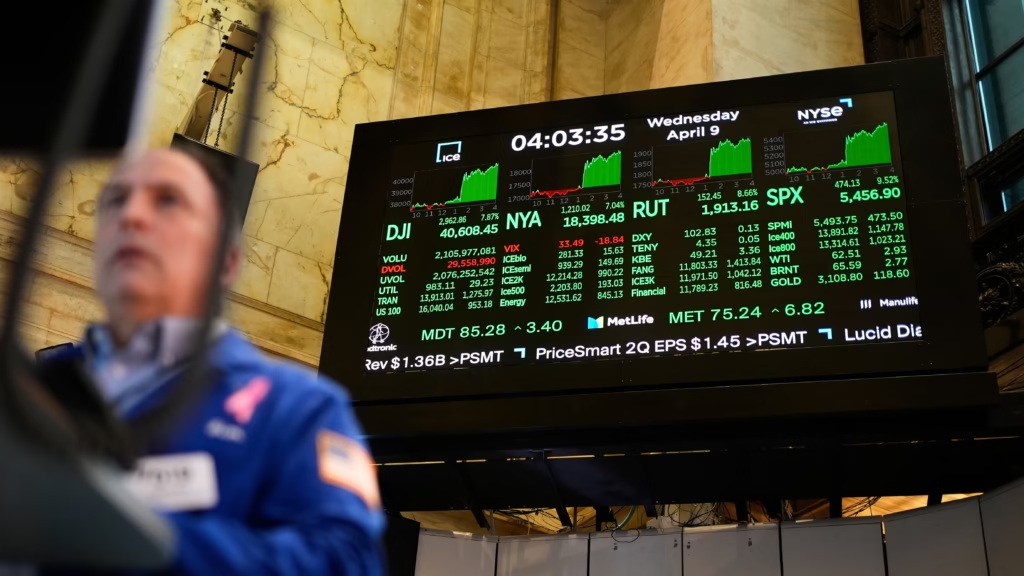China Trade War Stocks Escalates Under Trump’s 145% Tariffs
3 min read
China Trade War Stocks | Markets reel after White House confirms higher tariffs, reigniting investor fears amid trade tensions with China.
U.S. markets took a sharp turn downward Thursday as investors grappled with the economic fallout of escalating trade tensions between the United States and China. The renewed China trade war stocks narrative was reignited after the White House clarified that the tariffs on Chinese imports now total a staggering 145%, not the previously stated 125%.
This revision sent shockwaves through Wall Street, intensifying market volatility that had only briefly eased following a temporary tariff pause. The Nasdaq Composite plunged 4.3%, and the Dow Jones Industrial Average lost more than 1,000 points, or 2.5%. The S&P 500 also closed down 3.5%. | China Trade War Stocks

Why Investors Are Nervous |U.S.-China Trade Conflict
This spike in tariffs, part of President Trump’s aggressive second-term trade strategy, has not only rattled investor confidence but also cast a shadow over the global economic outlook. As markets tried to digest the implications, anxiety soared—reflected by a rise in the CBOE Volatility Index (VIX).
Gold, traditionally a safe haven, surged 3.2% to a new record of $3,155.20 per troy ounce, indicating mounting concern. Meanwhile, yields on 10-year Treasurys fell to 4.392% as bond prices rose.
China Responds, Global Markets React : Stock Market Turmoil
In retaliation, China announced it will cut imports of American movies, a move targeting the lucrative U.S. services sector. Additionally, Goldman Sachs revised its growth forecast for China, lowering its 2025 estimate to just 4% and expecting a further dip to 3.5% by 2026.
Despite a short-lived overnight rally in Asian and European markets, skepticism prevailed. The Nikkei 225, which had earlier risen 9.1%, opened Friday with a dramatic 5.4% drop. European indexes also followed suit.
| China Trade War Stocks

Inflation and Bonds: Mixed Signals
There was a brief glimmer of hope in the latest Consumer Price Index (CPI) report, which showed inflation slowing to a 2.4% annual rate—better than economists had forecast. As a result, short-term U.S. Treasury yields fell amid strong demand.
However, market optimism faded quickly as the broader implications of trade tension became clear. The U.S. dollar weakened, dropping more than 1% against a basket of major currencies.
International Pressure and Political Rhetoric
The European Union opted to suspend its retaliatory tariffs for 90 days to prioritize diplomatic negotiations, highlighting the fragile state of international trade relations. However, President Trump only escalated matters further, threatening tariffs and sanctions on Mexico over an alleged breach of the 1944 Water Treaty, claiming the country owes Texas 1.3 million acre-feet of water. | China Trade War Stocks
“This is about fairness to our farmers and protecting American interests,” Trump stated on Truth Social Thursday night. “Mexico has been stealing the water.”
The Bigger Picture: What’s Next?
The chaotic trading session reflects deeper worries among investors: higher tariffs could stall economic recovery, strain consumer spending, and lead to sustained inflation. Even with inflation softening, the uncertainty surrounding future trade relations continues to pressure stocks, currencies, and commodities alike.
For now, all eyes are on upcoming economic data and any further statements from the White House or China’s Ministry of Commerce. Markets remain on edge as the China trade war stocks narrative continues to evolve in real-time. U.S. Consumer Price Index – BLS | Goldman Sachs China Economic Outlook | CBOE Volatility Index – VIX | U.S.-China trade conflict
CONTINUE READING: Markets Soar After Trump Backs Down on Tariffs



